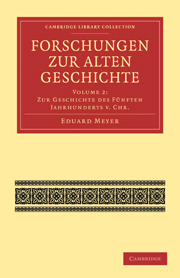Book contents
- Frontmatter
- Vorwort
- Inhalt
- I Die Biographie Kimons
- II Zur Geschichte der attischen Finanzen im fünften Jahrhundert
- III Wehrkraft, Bevölkerungszahl und Bodencultur Attikas
- IV Herodots Geschichtswerk
- V Thukydides
- VI Chronologische Untersuchungen. Die Regierungszeiten der persischen und der spartanischen Könige
- VII Zur Rechtfertigung des zweiten Bandes meiner Geschichte des Alterthums
- Index
III - Wehrkraft, Bevölkerungszahl und Bodencultur Attikas
Published online by Cambridge University Press: 03 May 2011
- Frontmatter
- Vorwort
- Inhalt
- I Die Biographie Kimons
- II Zur Geschichte der attischen Finanzen im fünften Jahrhundert
- III Wehrkraft, Bevölkerungszahl und Bodencultur Attikas
- IV Herodots Geschichtswerk
- V Thukydides
- VI Chronologische Untersuchungen. Die Regierungszeiten der persischen und der spartanischen Könige
- VII Zur Rechtfertigung des zweiten Bandes meiner Geschichte des Alterthums
- Index
Summary
Die Armee und die drei oberen Kiassen
Ueber die Bevölkerung des Staates Athen im fünften Jahrhundert ist so viel verhandelt worden ohne ein gesichertes und allgemein anerkanntes Ergebniss zu erreichen, dass es fast als ein hoffnungsloses Unternehmen erscheinen kann, die Discussion noch einmal wieder aufzunehmen. Und doch ist es unerlässlich, über diese wichtigste aller Grundlagen der militärischen Leistungsfähigkeit und damit der Macht des Staats wenigstens ein einigermaassen sicheres Urtheil zu gewinnen.
Den Mittelpunkt jeder Untersuchung über diese Fragen bildet die bekannte Ausgabe des Thukydides II 13,6, Athen habe beim Ausbruch des Kriegs, abgesehen von den an verschiedenen Stellen des Bundesgebiets) liegenden Besatzungen, 13000 Hopliten ins Feld stellen können; dazu seien 16000 Hopliten für die Besatzung der Mauern gekommen: „denn so stark war die Besatzung in der ersten Zeit bei jedem Einfall der Feinde, gebildet aus den ältesten und den jüngsten Jabrgängen (áπóτε τv πεσβvτtv χαI τv vεωτatv) und den Metoeken, welche als Hopliten dienten‟. Unter den ältesten und jüngsten Jahrgängen versteht man allgemein die Epheben, d. h. die jungen Leute vom Hoplitencensus im 18. und 19. Lebensjahre, die bekanntlich zwar als Hopliten ausgebildet und als ständige Besatzung zum Schutze Attikas verwendet, aber fiir den Krieg ausser Landes noch nicht gebraucht wurden, und die Jahrgänge, welche zum Felddienst nicht mehr verwerthet werden konnten, aber noch im Stande waren, auf der Mauer Wachtdienst zu thun und im Nothfall als Landsturm zu kämpfen. Ein derartiger Fall war schon 459 eingetreten, als, während ein Theil des attischen Heeres in Aegypten stand, ein anderer Aegina belagerte, die Korinther in Megaris einfielen.
- Type
- Chapter
- Information
- Forschungen zur Alten Geschichte , pp. 149 - 195Publisher: Cambridge University PressPrint publication year: 2010First published in: 1899



